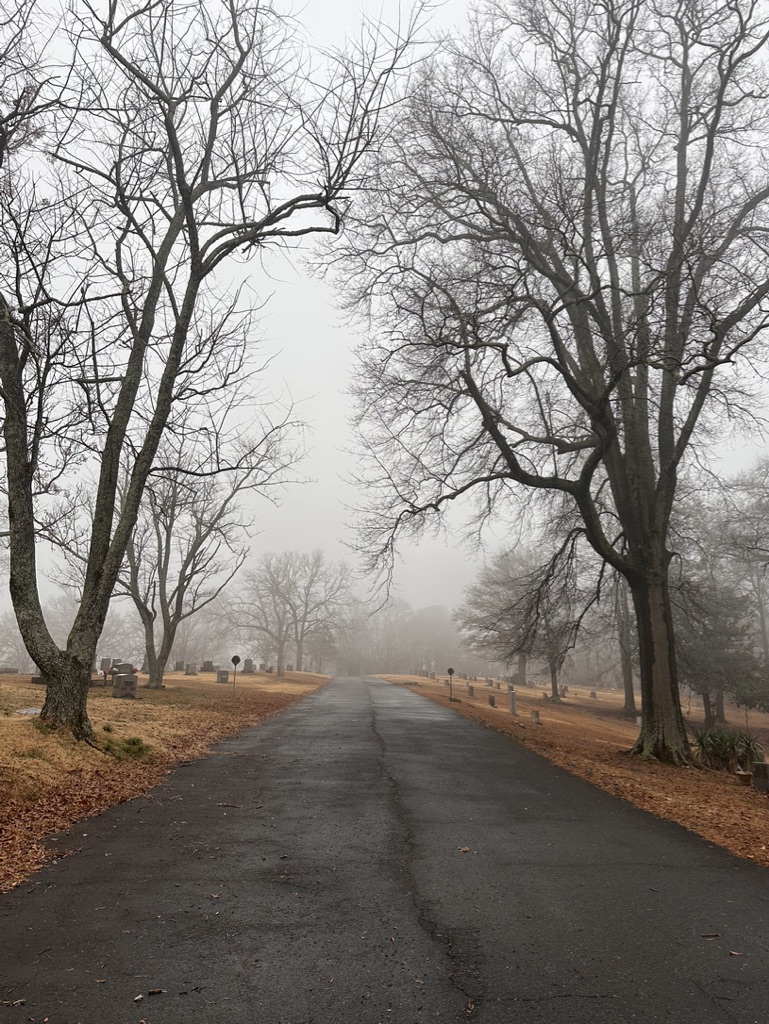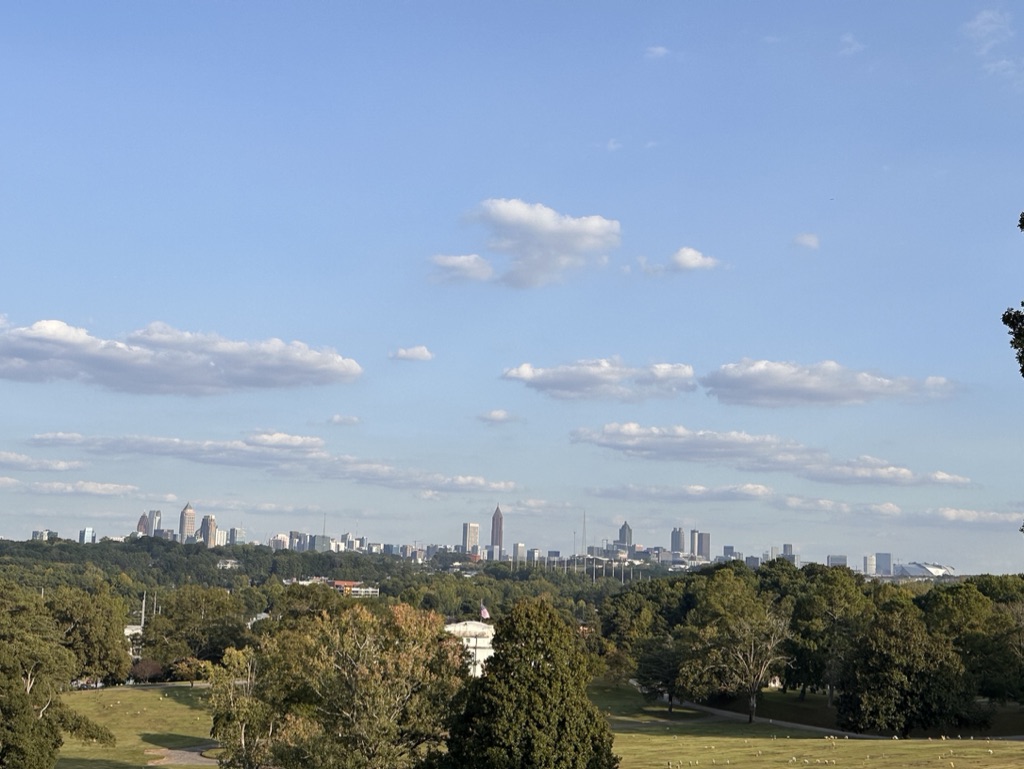Ode to Crestlawn Cemetery: A Tranquil Sanctuary in Atlanta
Nestled along Marietta Boulevard in Atlanta, Crestlawn Cemetery offers a quiet retreat from the city’s relentless energy. Sprawling across 145 acres of rolling hills and established trees, this cemetery may be less known than its historic siblings like Oakland or Westview, yet it holds its own unique place in Atlanta’s tapestry of memorial grounds. For me, it isn’t just a resting place for those who have passed: it’s a living archive of history, a sanctuary of reflection, and a daily source of inspiration. Whether I’m riding, running, or simply walking through its peaceful lanes, I find myself drawn into its embrace of tranquility and beauty.
A History Etched in Stone

The land that cradles Crestlawn Cemetery holds layers of history deeper than its graves. Before becoming a place of rest in 1916, these rolling hills played a pivotal role in the Civil War, serving as strategic high ground during the Battle of Atlanta. The very earth beneath my feet once held earthworks and fortifications, silent witnesses to Sherman’s Atlanta Campaign. Today’s peaceful paths trace what were once military positions, where Union and Confederate forces faced each other across these heights during that fateful summer of 1864.
Established as Atlanta entered a new era of growth and change, Crestlawn Cemetery quickly became more than just another burial ground. Home to over 50,000 burials, it holds the distinction of housing the oldest mausoleum west of the Allegheny Mountains, an architectural marvel that stands as a testament to the ambitions of a growing city. The grounds include five distinct Jewish cemetery sections, reflecting Atlanta’s diverse cultural and religious heritage, a progressive feature for its time that helped establish Crestlawn as one of Atlanta’s more inclusive sacred spaces.
These Jewish sections hold the remains of many influential Atlantans who helped shape our city’s character: William Breman, whose philanthropic spirit lives on through the Jewish Heritage Museum bearing his name; Rabbi Jacob Rothschild, the courageous leader of The Temple who stood firmly alongside Dr. Martin Luther King Jr. during the civil rights movement; Cecil Alexander, the visionary architect whose designs grace Atlanta’s skyline and who gave us our city’s forward-facing phoenix symbol; and Erwin Zaban, lovingly known as the “godfather of Atlanta’s Jewish community,” whose leadership helped build many of the institutions that define Jewish life in Atlanta today. Each name, each stone, each memory contributes to a larger story of community, courage, and progress.
Walking these grounds, one can’t help but feel the layers of history intertwining, from battlefield to burial ground, from division to unity. The transformation of this space from a theater of war to a garden of remembrance mirrors Atlanta’s own journey of healing and renewal, a testament to the power of time and intention to transform even the most contested ground into sacred space.
The Natural Beauty of the Grounds

Despite its somber purpose, Crestlawn is a celebration of life and nature’s enduring artistry. From certain vantage points, breathtaking views of the Atlanta skyline emerge between the trees, creating a poignant dialogue between past and present. On clear days, the vista stretches from Stone Mountain in the east to Kennesaw Mountain in the west, offering one of the finest panoramic views in the city, a secret I almost hate to share.
I’ve watched the sunset over this landscape more times than I can count, the last light catching on dewdrops and headstones alike, turning everything momentarily golden. There’s a particular spot near the eastern ridge where, if you time it just right in late October, the sunset aligns perfectly with the downtown skyline, creating a moment of such perfect beauty that it’s stopped me in my tracks more than once. The light reflects off the glass towers of downtown and midtown, casting a warm glow that enhances the serene atmosphere.
Thoughtfully designed pathways wind through venerable oaks and maples, some surely older than the cemetery itself. Their roots have grown around markers and monuments, creating a visual reminder of how nature and memory intertwine. A serene duck pond tucked away in the southwest corner offers moments of quiet contemplation, I’ve spent entire lunch breaks sitting on its banks, watching wood ducks glide across the surface, momentarily forgetting I’m in the heart of a major city.
The grounds burst with seasonal character: flowering dogwoods and azaleas in spring that explode in whites and pinks so vibrant they seem almost artificial; the deep, cooling shade of summer canopies that have saved me during many a scorching August ride; autumn’s rich palette that transforms the cemetery into a canvas of reds and golds; and winter’s stark, meditative beauty, when the bare branches reveal architectural details of monuments normally hidden by foliage. Each season brings its own gifts, its own invitations to pause and reflect.
A Cyclist’s Paradise

What makes Crestlawn truly unique among Atlanta’s memorial parks is its unexpected role as an urban cycling sanctuary. The cemetery’s narrow, well-maintained roads form a network of challenging climbs and exhilarating descents across its 200-300 feet of elevation change. Multiple routes to the summit allow cyclists to craft varied circuits, perfect for anything from quick training sessions to longer endurance rides. The smooth pavement and complete absence of traffic create an ideal environment for focused training or meditative spinning.
In summer, the mature tree canopy provides welcome refuge from the Georgia heat, creating natural air conditioning that’s saved me during many a midday ride. In winter, the grounds offer a safe haven for night riding away from city traffic, the lack of cars makes it an ideal location for night riding with a some lights.
Hidden among the main roads, a few discrete singletrack paths add variety for the more adventurous cyclist. I hesitate to even mention these, they’re not official trails, just worn paths created by decades of groundskeepers’ and neighbors’ shortcuts, but they offer moments of unexpected joy.
Whether grinding up the steep ascents or carving through the ripping fast descents, each ride here offers both physical challenge and spiritual renewal. It’s possible to string together enough variations to accumulate serious climbing over a one hour session, making this hidden gem one of Atlanta’s most versatile cycling venues.
Community, Memory, and Respect

Crestlawn is more than a historic site or a burial ground: it’s a living tribute to the community that has safeguarded these memories for generations. Over the years, I’ve encountered others who share my appreciation for this space: elderly couples walking hand-in-hand among the graves of friends long passed; history enthusiasts tracing the stories etched in stone; photographers capturing the interplay of light and shadow; and fellow cyclists nodding in quiet acknowledgment of our shared secret.
I’ve learned to move through this space with reverence, slowing down when funeral processions pass, dismounting near active burial sites, and always yielding to those who come to mourn and remember. There’s an unspoken code among those of us who use this space for recreation: we are guests in a place that serves a purpose far more significant than our temporary enjoyment.
This balance, between recreation and respect, between the living and the memory of those passed, creates a unique atmosphere unlike any other green space in Atlanta. It reminds us that even in places marked by finality, there lies hope, continuity, and an inherent respect for life’s journey. Each visit reinforces my connection to the stories held within these grounds while also reminding me to appreciate the fleeting yet beautiful moments of everyday life.
Conclusion: A Living Tribute
In the heart of Atlanta, where modernity often drowns out the whispers of the past, Crestlawn Cemetery stands as a timeless counterpoint. It is a gentle sanctuary amid urban tumult, where nature and memory coalesce into something greater than the sum of their parts.
On my most recent visit, as I crested the highest point just as the sun was setting, casting long shadows across the rolling landscape, I was struck by how this place has become a touchstone in my life, a constant in an ever-changing city. In a metropolis defined by perpetual reinvention, Crestlawn offers something increasingly rare: a space where time slows down, where history remains tangible, and where natural beauty persists despite the pressures of urban development.
As I continue to traverse its sacred paths, be it on a run, a bike ride, or a contemplative walk, I remain ever grateful for this place of peace, history, and beauty that so faithfully serves as both keeper of memories and source of renewal. In sharing this ode to Crestlawn, I hope others might discover their own connection to this remarkable urban sanctuary, ensuring its preservation for generations to come.
Stay in the loop
Get notified when I publish new posts. No spam, unsubscribe anytime.